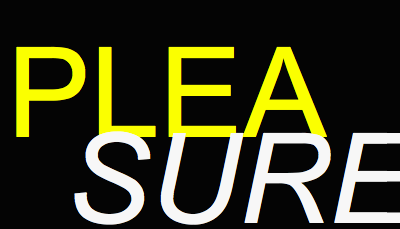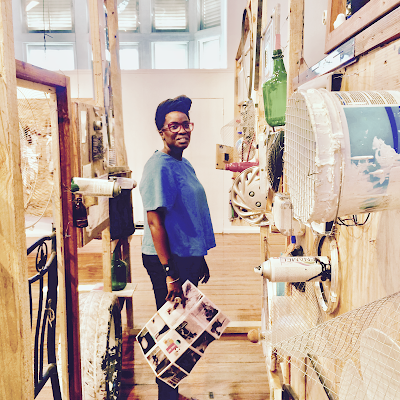Wherever I sat, there I might live,
and the landscape radiated from me accordingly.
- Henry David Thoreau
REX DIXON's talent for painting, poetry and prose shines bright in Travels with a Husband – a playful book that is intriguing, humorous yet ultimately slight notwithstanding the wealth of material it marshals.
Scholar and filmmaker Patricia Mohammed has made something of a companion piece to her beautiful film Seventeen Colours and a Sitar which documented the artistic pairing between her husband Dixon and sitarist Mungal Patasar. Whereas that film presented, "a marriage between intuitive and experimental ways of working" this book presents the marriage proper between Dixon and Mohammed.
But Travels with a Husband is not a juicy tell-all. As Mohammed states in the introduction, the title of the book is a pastiche of Robert Louis Stevenson's Travels with a Donkey in the Cévennes (1879) and Graham Greene's Travels with my Aunt (1970). Mohammed cheekily adds, "neither reference is literal but nonetheless some parallels may be drawn... the double entendre in the indefinite article is deliberate, open to anyone's interpretation." We identify easily with the two authors and are promised a book that gives us a glimpse of their life:
We are, like many others, very much products of the modern condition of being, always transitory migrants, not quite settled in any one place, and wary of the boundaries of nation, class, ethnicity or gender that attempt to define our lives. Like many others, we leave a little of our souls in each place we have visited or lived in for a while, and we take some of theirs with us, always adding to the imaginary landscapes that constantly fuel our creativity and joie de vivre.Yet, after 216 pages, we don't feel like we've had a meaningful glimpse of any of this. The book covers a dazzling array of countries, assembling short essays, poems and paintings. But the prose sections anchoring it all are problematically insubstantial.
 |
| Rex Dixon, Spanish Postcard, pencil on paper, 2000. |
Mohammed, who is the author of a book-length study on Caribbean iconography, writes the bulk of the book's passages. Her tone is often witty and wry. Her prose is strongest when she paints cameos of characters encountered during the couple's peregrinations across countries like Jamaica, Canada, Namibia, Spain, Japan, Haiti, the Netherlands, India, Australia, Cuba and Barbados. There are some memorable descriptive passages, such as this one about Jamaica:
The blue of this sea is not translucent aquamarine like Negril or Montego Bay. It is as changeable as a summer's day on the Antrium coast of Northern Ireland. Prussian blue in mid-morning, with a ribbon of lilac marking the horizon, and a white frothy lace, the shore.However, Mohammed's narratives sometimes over-reach, coming to grand conclusions without adequate development. You get the sense that she has held back the big ideas she wanted to explore. For example, we are left wanting to understand more about her views on resistance; crave a better examination of Namibia and its politics; wish for exploration of how "masculinity and nationalism is forever an ongoing game"; and definitely needed more on Cuba and Haiti.
 |
| Rex Dixon, Two Burning Cages, acrylic on canvas, 2013. |
Understandably, the authors were aware they were not writing an academic book. But a book like this has to be able to carry complex ideas in ordinary language. Some things here are simply too breezy. A narrower, more sustained focus would have been useful. We are left with a rushed feeling of fragments recollected by-the-way after the passing of years.
The real strength of the book, though, comes in how it showcases Dixon's art, including several of his paintings and multi-media collages done in a series of locations. Lines are never straight, brilliant tones are washed together, forms suggested, text and photographs merge. We ask: are we looking at animals, places or elaborate fonts spelling words we've never used?
 |
| Rex Dixon, Intuitive Painters Plus Dog, gouche on paper, 2005. |
Many influences loom: the fluid energy of Pollock, the graffiti-like abstraction of Basquiat, the palette of Chagal. But while his painting relishes in the ambiguous, Dixon's poetry and prose are crystal clear. In 'Poem with no name' he achieves a moment of excellence:
Van Bylandtstraat washed over in Payne's grey
A gloomy winter Sunday
On either side
aged houses sit like old men and women
rubbing shoulders and feet together
sending smoke signals through their chimney pipes
as if to say
there's life inside us still
Yesterday the shadows dancedAnd just as his paintings suggest a stylistic master, Dixon's prose has an understated grace and clarity that puts some more established writers to shame. 'Requiem for my grandfather' is a fine essay with the kind of touches that demonstrate a mature writer:
mischievous dwarfs along your rooftops
Today the dull red bricks lie sullen
drugged dreamless,
too weary resisting
the damp and cold.
One day when I was six, my mother took me to the railway station and, coming out of the steam was this tall man in an army uniform with a long kit bag slung over his shoulder. He came up to us and started kissing my mother. "This is your father, Matthew," she said. I realized then that I was also named after him.Unfortunately, the stance of both authors on contemporary art practices appears to be one of disdain, even if they have authored a book that places them at the centre of those practices. This is a work that demonstrates art's malleability and the usefulness of hybrid forms.
Also, it must be noted that the book feels heavy in the hand, there is no index of Dixon's artwork, no list of names or places and no pages for notes in the back, something readers travelling with Travelling with a Husband would have appreciated.
In the end, we find ourselves looking for the provocations and profound insights of books like Stevenson's Travels or even VS Naipaul's The Middle Passage. Instead, we end up feeling like we've spent a lot of time reading the trailer to a more serious movie the authors really want to make.

























